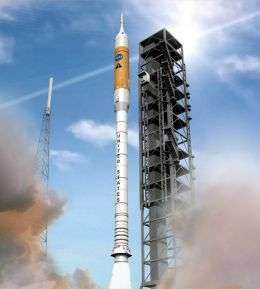Building a New Rocket for the Nation

The Ares I rocket, America's next flagship in space, is now in development by NASA and its industry partners, and soon will carry human explorers and new missions of discovery to the moon and beyond. And thousands of American workers in 32 states and Puerto Rico are helping make it happen.
Planning and building the Ares I, the first launch vehicle in NASA's robust, next-generation Constellation Program fleet, is truly a national effort, supported by more than 200 companies spread across the nation from Connecticut to California. The vast majority of them support one or more critical Ares projects: the rocket's first stage, upper stage or upper stage engine.
"These contributing companies and organizations across the nation are providing critical engineering expertise, hardware and materials fabrication and testing and a wide spectrum of support services," said Steve Cook, manager of Ares Projects at NASA's Marshall Space Flight Center in Huntsville, Ala.
"Their work ensures that NASA will, in the next decade, successfully fly the Ares I rocket to orbit to support the International Space Station and send Americans back to the moon, preparing the way for rewarding new journeys of discovery throughout the solar system," Cook said.
The 165-foot-long Ares I first stage, the backbone of the integrated launch vehicle system, is a five-segment solid rocket booster derived from the space shuttle's twin boosters, enhanced and reconfigured to produce greater thrust. Burning more than 1.3 million pounds of propellant in just 125.8 seconds, the first stage will propel the rocket to an altitude of roughly 36 miles before being jettisoned. As the Ares I upper stage engine ignites, the first stage will deploy parachutes and gently drop into the sea for recovery, analysis and reuse.
The 84-foot-long Ares I upper stage is propelled by a J-2X main engine fueled with liquid oxygen and liquid hydrogen. The J-2X is an evolved variation of two historic predecessors: the powerful J-2 engine that propelled the Apollo-era Saturn IB and Saturn V rockets, and the J-2S, a simplified version of the J-2 developed and tested in the early 1970s but never flown.
The J-2X will operate for approximately 465 seconds, burning more than 302,200 pounds of propellant, and shut down when Ares I reaches an altitude of roughly 83 miles. The Orion crew exploration vehicle then will separate from the upper stage, and its own engine will fire to insert the spacecraft into low Earth orbit. The upper stage will reenter Earth's atmosphere and splash down in the Indian Ocean.
NASA's Constellation Program fleet -- now more than four years into development -- includes the Ares I, the Ares V heavy cargo launch vehicle and the Orion spacecraft. The Ares V will serve as NASA’s primary vessel for safe, reliable delivery of large-scale hardware to space, including the Altair lunar lander, also now in development, and supplies needed to establish a sustained human presence on the moon. The Orion will safely ferry a crew of four to six astronauts to a variety of destinations in space.
The first Ares I test flight, called Ares I-X, is scheduled for 2009. The first crewed launch of the Ares I rocket is planned for no later than 2015, and NASA plans to send the first missions back to the moon around 2020.
"We're proud to help continue the nation's tradition of leadership in space," Cook said. "Since NASA's creation 50 years ago, our endeavors have yielded or inspired technology innovations that enrich nearly every commercial industry and benefit Americans and people around the world in countless ways.
"Our team effort on Ares I will continue that legacy," Cook said, "and also will help to stimulate our economy and reignite the country's passion to journey to worlds beyond our own."
Source: NASA's Marshall Space Flight Center





















